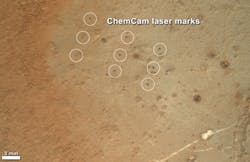Image from Mars rover Curiosity shows rock zapped by ChemCam's solid-state laser
Pasadena, CA--This image from NASA's Mars rover Curiosity, which comes via the Jet Propulsion Laboratory (JPL), shows nine pits created by the by the rover's Chemistry and Camera (ChemCam) laser, which is part of the ChemCam's laser-induced breakdown spectrometer (LIBS). The Q-switched, diode-pumped solid-state laser, developed by Thales Laser (Orsay, France), vaporizes a small amount of the target rock, creating a plasma that is spectroscopically analyzed to determine the proportions of different elements in the target, and thus the type of rock.
The image, taken by the rover's Mars Hand Lens Imager (MAHLI), shows details of rock texture and color in an area where the rover's Dust Removal Tool (DRT) brushed away dust that was on the rock. The rock was a candidate for the first use of the rover's drilling tool, but the target area (called "Wernecke") was ultimately not chosen for the rover's first drilling.
Also seen are the rock's natural fractures, white veins, gray and white nodules, pits, and small dark grains. Remaining clumps and specks of dust can also be seen. The scale bar at lower left is 3 mm.

John Wallace | Senior Technical Editor (1998-2022)
John Wallace was with Laser Focus World for nearly 25 years, retiring in late June 2022. He obtained a bachelor's degree in mechanical engineering and physics at Rutgers University and a master's in optical engineering at the University of Rochester. Before becoming an editor, John worked as an engineer at RCA, Exxon, Eastman Kodak, and GCA Corporation.
